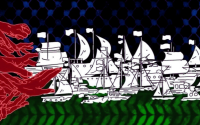14 October 2007Hank Green
There’s no use avoiding it: our kids need to know about the global environmental crisis — climate change, deforestation, species extinction. And as long as we’re teaching them about all that, we may as well teach them some science at the same time. Learning about evaporation can be as boring as watching a pot boil, but if it’s part of a habitat-destroying, polar-bear-killing, actually-somewhat-interesting environmental disaster, maybe that’s something kids could enjoy reading.
Here are two new books that don’t shy away from the complexity of the science or the gravity of our environmental situation, but which also don’t forget their audience. Never before have so many serious ecological ideas been mixed so heavily with flatulence jokes and sad pictures of cute animals. The details of global warming boggle some of the world’s finest minds, but Laurie David and Cambria Gordon’s “Down-to-Earth Guide to Global Warming” actually makes it easy to understand. The first third of the book is dedicated to the science behind climate change. And while nitpickers may find the lack of references and occasional simplifications annoying, I’ve never seen a more comprehensive explanation of the phenomenon in so few words.
The authors may reach a bit when they try to sound less square, likening the buying of compact fluorescent light bulbs to “an upgrade on your iTunes software.” But they make the science relevant and enjoyable with abundant visuals and conclude with some meaty ways for kids to make a difference. The old standbys are all there (switch light bulbs, recycle, use canvas bags at the grocery store). But I smiled on noticing something new: the authors suggest some “sustainable careers” kids can consider, like meteorologist and “glacial geologist.”
Global warming may be the biggest and most complex environmental problem we’re facing, but it’s not the only one. Loree Griffin Burns’s “Tracking Trash” takes on the problem of waste in the world’s oceans.
Her story begins in 1990, when thousands of mysterious sneakers washed up on beaches in New England. Curtis Ebbesmeyer, an oceanographer, set out to track their origin. Burns tells his story, along with those of other scientists and citizens who track trash, and shares their genuinely fascinating and important discoveries about oceanic currents. It’s a science text, but there’s a bit of detective novel thrown in as well.
Of course, the publishers embrace the environmental theme: the cover of the book features both a litter-strewn beach and a net-strangled seal. But most of the book is about scientists doing science. Useful sidebars in every chapter serve to teach concepts like latitude and longitude, and the importance of plankton. The book hits its climax with some frightening bits about trash and discarded fishing nets floating through the ocean, destroying reefs and killing birds, turtles, sharks and other creatures. But the work of our fearless scientists (which began with tracking those shoes, which fell off a cargo ship) leads to techniques for helping prevent further destruction of our ocean ecosystem.
Is it foolish to be somewhat glad that a global environmental crisis is providing an exciting framework within which kids can learn science? Well, yes, of course it is. But these two books are a pretty fine silver lining to that looming storm cloud.






